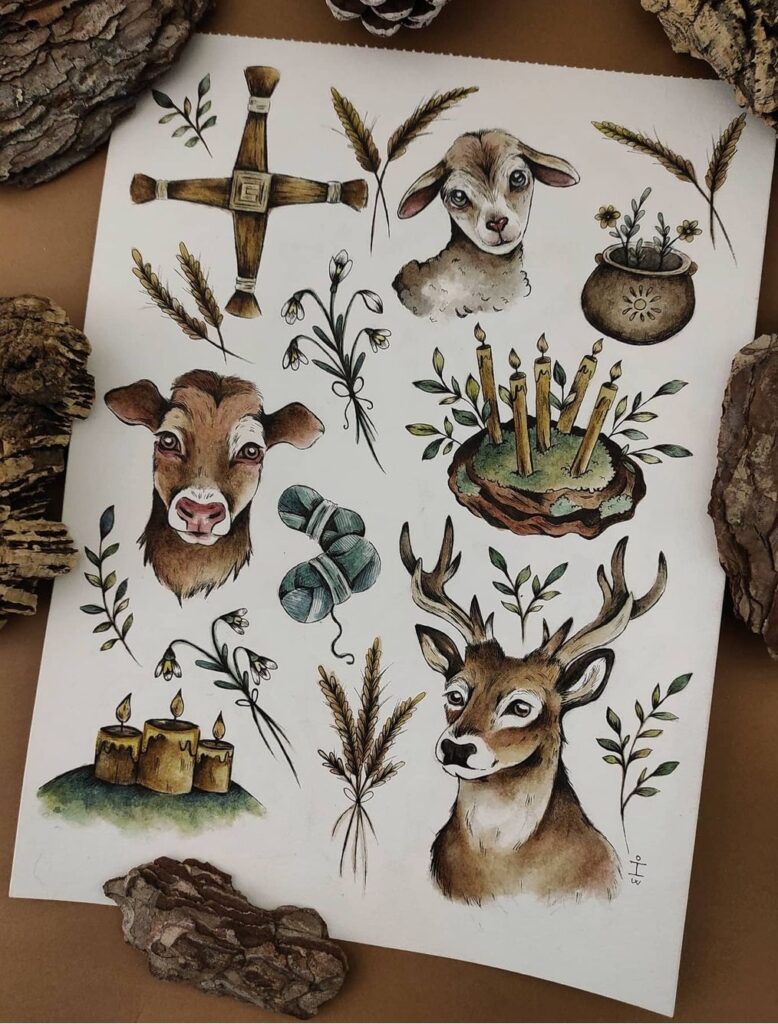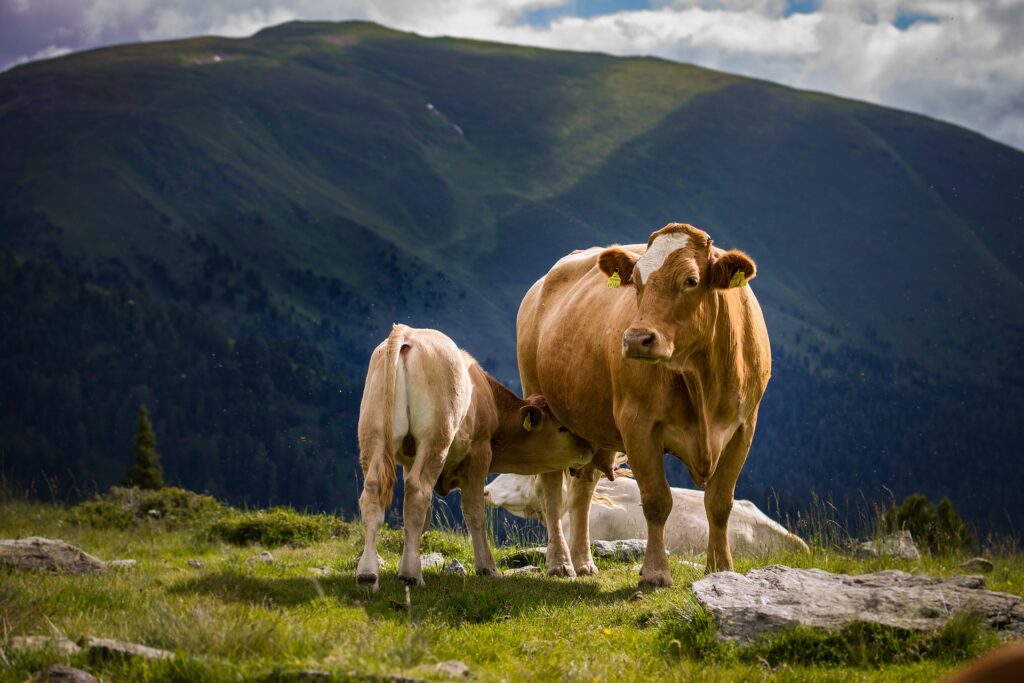No products in the cart
Ostara and its animals: a story of Easter and Springtime
I had in mind to bring this post for Ostara but decided to wait until Easter. Here...


I didn't want to miss the opportunity to wish you a nice Imbolc and what better way than doing it here, through my little project born this year. For me it means the transformation of part of my work: hours of drawing into hours of writing and it is being something liberating.
To be honest, I never liked the month of February. Maybe because I was still dragging the sadness of Christmas or because in college it was synonymous with exams and I literally got sick during exams. Now, with this blog, I keep track of the events that take place during these dates and it has helped me to reconcile with it. I also think that the way I have lived January has had something to do with it.
I basically stayed still (metaphorically speaking), conserving what little warmth I had left and not trying to keep up an unsustainable pace. Because even though we are told that we have to be productive all year round, there are times when we can't. And after all that Christmas means to me, I just can't. And for me, after all that Christmas means to me, I just can't. It has been nothing else (and to sum it up a lot) than doing some introspection work. The hippy witch in me says that I have tuned in to nature and its seasons. The rational person in me says I've simply taken a vacation.
I guess they are both a bit right, although sometimes they get each other to death and I find myself in the middle. Anyway, it has helped me to understand what I come to tell you this week: the feast of Imbolc, the changes it represents and the animals with which it is associated and to which we can turn to (spiritually speaking) to understand the point we are at. Because first and foremost, this is a blog about animals and they are always the protagonists, regardless of the subject. Are you ready?

Imbolc is a Celtic festival that has special repercussions in Ireland and Scotland, although today it is widely celebrated among pagans of all kinds. The word "Imbolc" itself is related to animals, especially sheep and their gestation process. It derives from "Imbolg" or "Oimelc", meaning "milk" or "in the womb", which evidences the importance of new life and lactation. Let's think that nowadays the cycles of cattle are altered and their reproduction does not have to coincide with the natural tendency: mating in autumn and giving birth in February, something that does happen in the past, where societies depend on the seasons (for better and for worse). The arrival of milk and increased daylight hours are signs that spring is approaching.
It is impossible to talk about Imbolc without mentioning the goddess Brigid. In a way they symbolize the same thing: transformation and new beginnings. Brigid's adaptability is evidenced by the fact that she is one of the most venerated goddesses and her cult continues to this day. Such is her impact that she became a Saint for Christians (Saint Brigid). She is associated with the Earth and fire. She is often invoked to protect the home (it makes sense if we take into account that mismanaged fire could destroy the house) hence crosses and dolls are used in her name as protection. As Goddess of the Earth, she stays close to animals and is able to understand them, especially those with an important role in animal husbandry.
Looking for similarities in animals that help us understand seasonal phenomena is a good way to connect with the Earth. Brigid is related to several, but I would like to focus on those that can help us understand this holiday.
Possibly the cow is the animal most closely related to Brigid. Its ability to provide milk and its relationship with abundance, fertility, love or home make it a perfect companion. The image of Brigid next to a cow symbolizes the recovery of nature after the winter. The cow that accompanies her is not just any cow: she is tremendously productive and her milk has healing properties. It is believed to symbolize the sacredness of motherhood and represents the struggle for the well-being of offspring.


The role of the sheep in the functioning of the Celtic community is indispensable. It symbolizes abundance, balance, security and beginnings. It is not in vain that the word Imbolc itself refers to its first lactation and its relationship with spring. The sheep is also a reminder that with the passage of time everything changes. Brigid is related to the king of rams, a creature called Cirb.
The presence of snakes on the earth was long assumed to be an unmistakable sign that spring was near. It symbolizes change, beginnings, rebirth and wisdom. Brigid is often depicted holding a snake. They are admired for their ability to shed their skin and renew themselves. Ultimately this is what Imbolc represents, so their link is inevitable.

In addition to these animals linked to Brigid, there are others that present a similar behavior to the awakening of the Earth, such as the hibernating species. They spend the winter in their burrows, with activity at a minimum, in an environment that can remind us of the warmth and security of the maternal womb. Keeping them in mind during this time can help us gather strength for what is to come and not feel guilty about the inactivity of the winter months.
In different cultures they have been kept in mind when predicting how long the winter would be. If on the day of Imbolc (or another holiday according to tradition) they come out of their burrow and are able to see their shadow (because it is a sunny day) it means that winter will last six more weeks and they go back inside. If it is cloudy and therefore, they do not see their shadow, they leave the burrow and it means that spring will soon come.
The cult of the bear is possibly one of the oldest and most complex I know. Very often it is related to the female figure, it is associated with Brigid and the power of rebirth and regeneration. In the bear's behavior we can observe the passing of the seasons. At the beginning of winter it begins its hibernation where it remains still and hidden, almost dead.
With the arrival of Imbolc, their activity begins. Some mother bears are even accompanied by cubs that they have given birth to in the den. For our ancestors this inspires all kinds of legends, such as the possibility that the bear came back from the dead and was able to communicate with the other world. It also possesses the power to create life in death, which makes it an animal with a complex and powerful symbolism that would require much more space than I have available here.

And I did not want to finish without mentioning an animal that, although it is not related to Brigid, seems to me essential.
The groundhog symbolizes beginnings, community, cycles and family. It is tremendously linked to the energy of the earth. When talking about it, one inevitably thinks of Groundhog Day, celebrated in the United States on February 2. Here we have a well-known example where the behavior of a hibernating animal "predicts" the length of winter. It is a holiday celebrated around Imbolc and has the same elements at its core: the end of winter, the beginning of spring and an animal closely linked to the earth and natural cycles.

I find it interesting to remember that many cultures have their own traditions with which they celebrate this awakening. For example in China they celebrate the new year: a propitious time to clean and start new projects (similar to Imbolc). They also have animals with which they identify (although that's another story).
In the modern era many of us try to imitate the natural cycle and to some extent the behavior of animals (within our means). Now is the time to finish our time of introspection and sort out our thoughts in order to look forward to what spring has in store for us.
Bibliography
Neal, C. F. (2015). Imbolc: Rituals, Recipes & Lore for Brigid's Day. Llewellyn Worldwide.
Storl, W. D. (2018). Bear: Myth, Animal, Icon. North Atlantic Books.Weber, C. (2015). Brigid: History, Mystery, and Magick of the Celtic Goddess. Weiser Books.
What did you think of the post?
You may also be interested in...
I had in mind to bring this post for Ostara but decided to wait until Easter. Here...
I went to the premiere of Fantastic Beasts: The Secrets of Dumbledore and already at the...
I have to confess that when I started in the witchcraft world, the subject that most interested me was...
0 comments